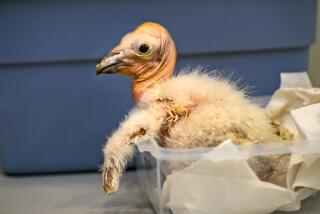California Condor Killed by Antifreeze, Officials Say
VENTURA — The endangered California condor that died last month fell victim to the same syrupy sweet substance that has poisoned many a household pet--a puddle of antifreeze probably leaked from a car radiator.
The bird called Chocuyens (Cho-KOO-yenz) died of kidney failure after it drank ethylene glycol, a toxic fluid used in antifreeze, U.S. Fish & Wildlife Service officials said.
Chocuyens was one of two California condors released into the wild in January as part of a project to restore the nearly extinct species that once dominated the skies of California.
Wildlife officials suspect that the vulture drank the fluid at one of the popular boating or off-road vehicle recreation areas in the eastern end of Los Padres National Forest or the western tip of Angeles National Forest. The coolant has a sweet flavor that is attractive to domestic and wild animals, they said.
“Ethylene glycol is just one of the problems we face with civilization here in Southern California,” said David Ledig, wildlife biologist and assistant project leader with the program.
Although discouraged by Chocuyens’ death, biologists with the service’s Condor Recovery Project said it would not affect the program or the plan to release six condors raised in captivity next month.
“We’re going forward from here,” Ledig said.
Chocuyens, a 15-month-old male condor with a nine-foot wingspan, and 17-month-old Xewe (GAY-wee), were the first two California condors to fly in the wild since the last of the birds was captured in 1987 as part of a captive breeding program at the San Diego and Los Angeles zoos.
Chocuyens was found dead Oct. 8 by Fish & Wildlife biologists about one mile south of Pyramid Lake Dam and about six miles north of the northern border of the Sespe Condor Sanctuary. The 53,000-acre sanctuary is about 20 miles north of Fillmore.
At first, the condor’s death baffled biologists and zoo pathologists who performed a necropsy on the animal. But toxicology tests performed at the University of Illinois identified ethylene glycol poisoning as the cause of death.
The bird probably found the antifreeze while stopping for a drink in one of the region’s recreation areas, such as Pyramid Lake, Lake Piru or Hungry Valley, wildlife officials said. After ingesting the coolant, Chocuyens would have been incapacitated for four to six hours and would have died soon afterward from kidney failure.
Chocuyens’ death and an attempted shooting of Xewe in July underscore the fact that many people are ignorant of the struggle to keep the birds from becoming extinct, wildlife service spokesman David Klinger said.
“It calls on us to redouble our efforts with the National Forest Service to get the message out to people that they need to be very, very careful when they are in the forest because of the big birds and their curiosity,” Klinger said. “We considered problems with pesticides and lead in the environment, but who would have thought of antifreeze?”
More to Read
Sign up for Essential California
The most important California stories and recommendations in your inbox every morning.
You may occasionally receive promotional content from the Los Angeles Times.










